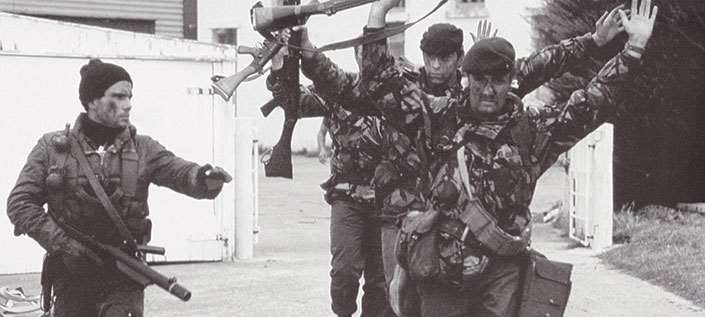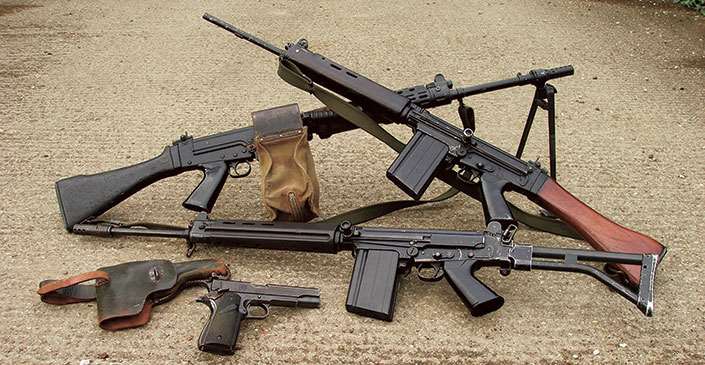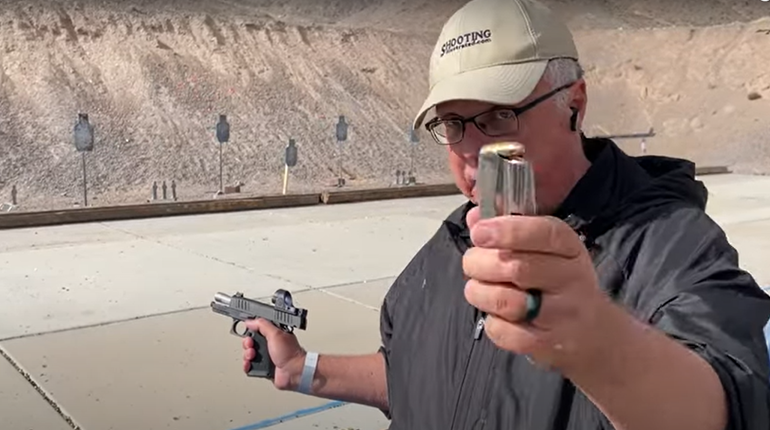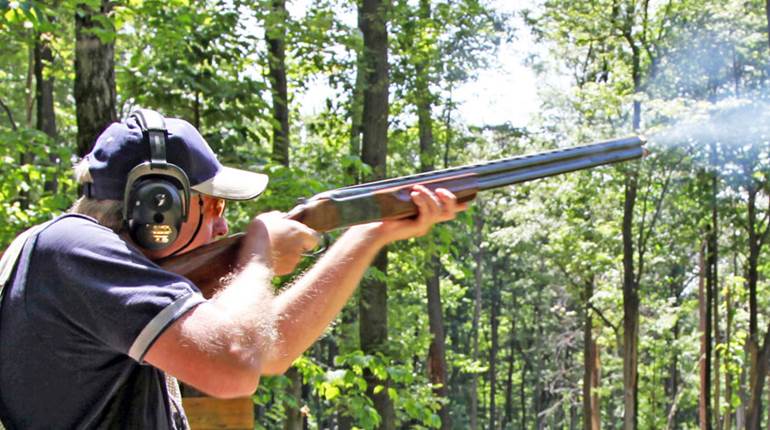
Corporal Peter Robinson of 45 Commando Royal Marines “yomped” down the dirt track that leads from the foot of the Two Sisters to Moody Brook with his L1A1 SLR on June 14, 1982. This photograph, taken by Royal Navy Petty Officer Peter Holdgate, is probably the most famous image from the conflict.
Photos courtesy of After the Battle
In 1982, Argentine troops occupied a group of islands known to them as the Malvinas, but to the British the islands were the Falklands. The result was a ground war that pitted troops equipped with remarkably similar small arms against each other.
Most people alive in 1982 remember it well. It was the event that sent us all to the atlas to look-up the location of the Falkland Islands (known as Islas Malvinas in Argentina). It was the event that pitted British Prime Minister Margaret Thatcher against Argentine dictator Leopoldo Galtieri. Triggered by competing territorial claims to remote islands in the South Atlantic, the brief but intense conflict remains a stunning example of modern air and naval war. But despite all its modernity, the Falklands/Malvinas conflict hinged on plenty of conventional land warfare. While Mirage and Harrier jets streaked across the sky above, British and Argentine troops struggled against one another with rifles and machine guns on the ground.
During the pre-dawn hours of April 2, 1982, Argentina set in motion Operation ROSARIO—the invasion of the Falkland Islands. At Mullet Creek south of Port Stanley, 94 heavily armed men from the Amphibious Commando Group landed by rubber rafts at 0430 and moved toward Stanley—population 1,800. Then at 0540, the 2nd Marine Battalion began landing at Yorke Bay north of the airport in 20 American-made LVTP-7 Amtracs. As almost 1,000 Argentine Commandos, Marines and soldiers descended on Stanley, they made contact with the city’s defenders: 68 Royal Marines of Naval Party 8901. With a numerically superior enemy force closing-in, the defenders pulled back to positions around Government House at 0715 and prepared to make a last stand.

Royal Marine Cpl. George Gill was staring through the scope of his sniper rifle when Argentine troops came out from behind cover near his position. He squeezed the trigger on his L42A1 Enfield and it bucked as a 7.62 mm bullet zipped downrange. One of the finest sniper rifles ever made, the 10-pound L42A1’s deadly accuracy served the task effectively. “I had a couple of them in my sights and made sure they were taken out of the game,” Gill recalled. For the next two hours the British held their ground, but then the Argentines brought up Amtracs for support. At that point, Argentine Commandos swiftly moved into the building complex from several directions in a final assault that overwhelmed the Royal Marines of Naval Party 8901.
Sargento Manuel Batista was particularly well-armed for this type of close-quarters firefight: He carried four fragmentation hand grenades, an Argentine-made 9 mm Browning Hi-Power pistol and a suppressed L34A1 Sterling submachine gun. He kicked-in the door to the first outbuilding he came to, quickly collected several prisoners and then moved-on to capture a group of Royal Marines around the outside of Government House. Batista then lead his prisoners into the parking area in front of the maid’s quarters where they were disarmed and searched. Another group of Royal Marines were similarly handled in front of the island’s Cable and Wireless Office after surrendering.
With the fall of Stanley on April 2 and the island of South Georgia the following day, it seemed that Argentina had finally cemented its long-disputed territorial claims to the islands of the South Atlantic. While the world wondered how England would react, the images of disarmed Royal Marines face-down in the street filled Margaret Thatcher with resolve. That same day, she addressed Parliament regarding Argentina’s “unprovoked aggression” against sovereign British territory. The Prime Minister concluded her speech with these words: “It is the government’s objective to see that the islands are free from occupation and are returned to British administration at the earliest possible moment.” Almost immediately, England began assembling a naval task force to conduct Operation CORPORATE: the counter-invasion of the Falkland Islands.

In anticipation of just such a response, the Argentines began to flood Islas Malvinas with thousands of reinforcements. By day and night, C-130s flew into the airport at Stanley delivering planeloads of fresh troops—troops who carried an interesting variety of small arms. Principal among them was Fabrique Nationale’s venerable Fusil Automatique Léger (Light Automatic Rifle). Argentina adopted the FAL in the late 1950s with the direct purchase of rifles produced at FN in Herstal, Belgium. Then in 1960, the Dirección General de Fabricaciones Militares (the General Directorate of Military Manufacturing, or “DGFM”) began domestic production of the FAL at the state-owned Fábrica Militar de Armas Portátiles (Military Small Arms Factory, or “FMAP”) Domingo Matheu factory in Rosario. The DGFM produced the FAL in four models: the standard FM FAL (Fusil Automatico Liviano or Light Automatic Rifle) Model 50-00; the folding stock FM FAL Model 50-61; the short-barreled Paracaidista Model 50-63; and the Model 50-41, known as the FAP (Fusil Automatico Pesado or Heavy Automatic Rifle). In addition to their DGFM FALs, Argentine battalions were also armed with FN’s legendary 7.62 mm Mitrailleuse d’Appui Generale (MAG) general purpose machine gun.
Although these arms were present by the thousands in the streets of Stanley during April 1982, Argentine troops also carried other domestically manufactured military firearms. Alongside their MAG machine guns, some Argentine units were still using the ALAM-1 machine gun in the Falklands/Malvinas. Chambered in the 7.65x51 mm cartridge, the ALAM-1 was the DGFM’s copy of the U.S. M1919A4 air-cooled machine gun. There were also two different DGFM 9 mm blowback submachine guns: the more modern FMK-3 and the PAM-II (Pistola Ametralladora)—a copy of the U.S. M3A1 “Grease Gun.”
Most Argentine officers carried the standard sidearm in general issue in 1982 —the DGFM’s version of the Hi-Power—but some still carried something older and more powerful. Between 1927 and 1966, the DGFM’s Domingo Matheu factory produced the Sistema Colt Cal. 11.25 mm Modelo 1927—a licensed copy of the M1911A1 pistol. Many Argentine officers preferred the extra punch of the .45 ACP Sistema 1927 over the 9 mm Luger. There were also a few arms of foreign manufacture among the various Argentine units in the Falklands/Malvinas. British-made L2A3 Sterling submachine guns, Belgian-made FN UZI submachine guns and even Italian-made Beretta BM-59E rifles were in the hands of the extremely well-armed occupying force.
Through the remaining weeks of April, Argentine units moved into the jagged hills surrounding Stanley and began preparing for a defensive campaign on the ground. They planted anti-personnel land mines by the thousands and they dug-in, creating fighting positions amid the wind-swept rocks. But the conventional ground forces would have to wait-out a seven week interim of escalating air and naval warfare. On May 1, British combat operations in the Falklands began when Royal Air Force and Royal Navy aircraft carried out the first airstrikes against Argentine positions around the Stanley airport. As the naval and air wars unfolded with each passing day, the British carried out a daring raid on the airfield on Pebble Island on the night of May 14-15. In the raid, the 45 men of D Squadron, Special Air Service infiltrated using two Sea King helicopters and proceeded to destroy 11 Argentine aircraft on the ground. In addition to mortars and rockets, the SAS fought the battle using American-made M16 rifles equipped with 40 mm M203 grenade launchers.
The true watershed event of the Falklands/Malvinas War came on May 21 when 3 Marine Commando Brigade conducted an amphibious landing near the settlement of San Carlos. Encountering only light opposition upon landing, the brigade’s 4,000 troops moved quickly to expand the beachhead and commence offensive operations. Although that part of the operation went well, Argentine aircraft responded with a series of devastating attacks against the Royal Navy warships supporting the force ashore. To protect the troops on the beachhead from low-level strafing attacks, the British used another legendary American firearm: the M2HB .50 BMG machine gun. While the air and sea campaign raged, British ground forces began to push-out from the invasion beaches with the ultimate goal of conducting a direct assault against Stanley, 50 miles away.
With a mountainous interior and an almost total absence of roads, moving the assault force into position around Stanley presented the British with an enormous challenge. The original plan called for the troops to be flown across the island, but almost all of the helicopters that were supposed to do the job went down when the Atlantic Conveyor was sunk. This development meant that some British units would have to walk—or “yomp” —their way across rugged terrain in the worst possible weather.

During the pre-dawn hours of May 28 the first significant land battle of the war began when the 2nd Battalion of the Parachute Regiment attacked the airfield at Goose Green. Under the command of Lt. Col. Herbert “H” Jones, the men of 2 Para carried the typical assortment of automatic arms organic to a battalion in the British Army in 1982. Some of the men were armed with 9 mm L2A3 Sterling submachine guns, while the majority carried another derivative of the FN FAL—the L1A1 Self Loading Rifle (SLR). Just like their Argentine adversaries, the Brits also carried a version of the FN MAG—the L7A2 General Purpose Machine Gun (GPMG). They also used a few U.S.-made 40 mm M79 grenade launchers. Finally, the battalion’s officers carried the L9A1 pistol—Britain’s version of the renowned FN/Browning 9 mm Hi-Power. The men of 2 Para struck out to capture Goose Green “before breakfast,” but stiff resistance from Argentine troops dug-in on Darwin Ridge caused the attackers to lose momentum. The British surged forward several times throughout the morning only to be stopped by heavy automatic fire from Argentine infantrymen on the ridge. At a critical moment in the battle, Lt. Col. Jones decided to lead an attack on a machine gun position and sprinted toward the enemy firing his L2A3 submachine gun. Half way up the hill, he paused to reload the Sterling and, as he started off again, a single 7.62 mm bullet struck him just behind his right collarbone and exited through his abdomen. He was killed instantly and was posthumously awarded the Victoria Cross for his leadership and courage. The battle reached its official conclusion the following day when more 1,000 Argentine troops surrendered.
The next phase of the advance toward Stanley commenced immediately following the victory at Goose Green when all British units began to push eastward. In the north, 3 Para and 45 Commando departed San Carlos on foot and yomped to Teal Inlet and Mount Estancia. In the center, 42 Commando and the SAS moved by helicopter over the center of the island to Mount Kent. In the south, 2 Para and the newly arrived 5th Infantry Brigade moved by helicopter and ship from Goose Green to the Fitzroy/Bluff Cove area. With those elements in place, British forces were positioned to launch their final attack. The effort kicked-off in the bitter cold of the night of June 11 with a brigade-sized operation that produced a trio of intense battles. Five miles west of the city, 45 Commando assaulted into positions occupied by the Argentine 4th Infantry Regiment on the Two Sisters hill mass. Silhouetted by the moonlight, the Brits came under devastating fire from Argentine M2 HB .50-cal. machine guns as mortar rounds rained down around them. With fire support from the guns of the destroyer HMS Glamorgan, the Royal Marines ultimately prevailed. Less than a mile away to the south, 42 Commando and the 1st Battalion Welsh Guards fought a desperate battle on Mount Harriet.
Across the valley floor to the northeast, the men of 3 Para simultaneously assaulted positions occupied by the Argentine 7th Mechanized Infantry Regiment on Mount Longdon. As the men of 3 Para attempted to advance up the slopes, they ran headlong into opponents who met their attack with a mixture of DGFM PAM-II Grease Guns, FAL rifles, FAP light machine guns and MAG belt-fed machine guns. In addition to that, a Marine heavy-weapons platoon manned several M2HBs on the mountain. In the confused darkness, paratroopers stormed the Argentine positions and engaged their adversaries in vicious hand-to-hand combat with buttstocks and bayonets. At a critical point in the fight, the 4th Platoon of B Company/3 Para received orders to conduct a reconnaissance of the north side of the ridge in an attempt to outflank the enemy positions.
Unknowingly, the recce force moved into the field of fire of yet another concealed Argentine machine gun. With no other option, the platoon leader charged the position only to be wounded. Without hesitating, 29-year-old Platoon Sgt. Ian John McKay took-over and rushed the machine gun firing his L1A1 SLR. After covering the distance rapidly, he hurled fragmentation hand grenades at the position—neutralizing it and killing the men inside. However, gunfire from elsewhere on the mountain then struck and killed Sgt. McKay. The courage and inspirational leadership he displayed that night on Mount Longdon was ultimately recognized when he was posthumously awarded the Victoria Cross.
The British resumed the attack during the night of the 13th when 2 Para attacked Wireless Ridge and the 1st Battalion/7th Gurkha Rifles attacked Mount William. Meanwhile, the 2nd Battalion Scots Guards went up against the Argentine 5th Marine Infantry Battalion in a dramatic action on Mount Tumbledown that concluded with a bayonet charge. Driven out of their defensive positions in the surrounding hills, Argentine units retreated back into Stanley in disorder. Soon, a white flag could be seen waving over the city, and then at 9:30 p.m. local time June 14, 1982, the surrender was signed, ending the war. Shortly thereafter, Maj. Gen. Jeremy Moore announced: “The Falkland Islands are once more under the Government desired by their inhabitants—God Save the Queen.”
More than 10,000 Argentine men became prisoners of war the next day. As they marched off into captivity, they piled-up thousands of DGFM rifles and machine guns at several collecting points in Port Stanley—a testament to Argentina’s failed attempt to control the Falkland Islands. This failed attempt resulted in the loss of 649 Argentine and 258 British lives and forever altered the future of both nations. Although more than 25 years have passed since the Falklands/Malvinas War, in Argentina it remains a sensitive subject. Throughout that country today, bumper stickers and signs can be seen that announce: “After 25 years it’s the same feeling: they were, they are and they will always be Argentine! MALVINAS!”





































